3.1 Perception & Persuasion
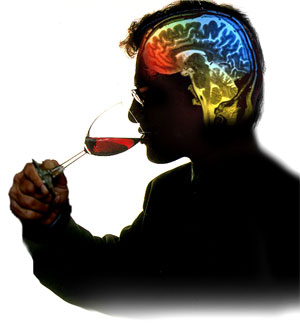 As we know from our study of the senses in Section 1, during the interaction between ourselves and wine, the impression we form is an experience that involves a synthesis of information from at least four different senses: Smell, taste, touch (or mouth-feel) and sight (covered in detail later in this section). However, by dividing the activity of wine tasting and focusing on its component parts, it is easy to forget that sensations from these parts must at some stage become unified then 're-presented', and it is the brain which provides us with the final, unified tasting experience.
As we know from our study of the senses in Section 1, during the interaction between ourselves and wine, the impression we form is an experience that involves a synthesis of information from at least four different senses: Smell, taste, touch (or mouth-feel) and sight (covered in detail later in this section). However, by dividing the activity of wine tasting and focusing on its component parts, it is easy to forget that sensations from these parts must at some stage become unified then 're-presented', and it is the brain which provides us with the final, unified tasting experience.
Some commentators have taken this observation to an extreme, arguing that,"The [wine] critic is actually describing a conscious representation of their interaction with the wine, and therefore the score or rating is a property of that interaction and not of the wine itself." (1)
Here is an invitation to philosophy which we will not pursue too far. Suffice to realise that wine is a natural beverage to which the mind contributes to it moulding forms, possibly as much as wine contributes by its stimuli. Our perception of flavour must be to a degree specific to ourselves, but it is unreasonable to think that when we judge a wine we are in fact examining ourselves and that the wine itself has nothing at all to do with it.
The question is: To what degree and by what are our representations of wine determined?
How electrical currents from nerve cells are translated then constructed into a representation of wine in the brain and how this might lead to different perceptions of the same wine amongst individuals is the subject of current research using fMRI scanning technology (Functional Magnetic Resonance Imaging). This technology essentially allows researchers to visualise the brain in action *.
There is a very interesting paper by Dr.Jamie Goode which reports some of the findings of this research:
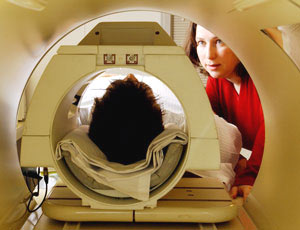 Inside the fRMI machine. |
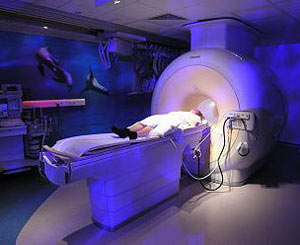 External view of the fRMI machine. |
"In 2002, researchers from the Functional Neuroimaging Laboratory of the Santa Lucia Foundation in Rome, headed by Dr Alessandro Castriota Scanderberg, put together a simple yet elegant study addressing a key question: do trained tasters experience wine differently from novices? They took seven professional sommeliers and seven other people matched for age and sex but without specific wine-tasting abilities, and they monitored their brain responses while they tasted wine. But getting someone to taste wine while they are having their brain scanned is no trivial feat. 'The experience was pretty uncomfortable,' recalls Andrea Sturniolo, one of the sommeliers involved. 'I was under a tunnel with four plastic tubes in my mouth, totally immobile.' [right] Through these tubes the researchers fed subjects with a series of four liquids: three different wines and a glucose solution as a control. Subjects were told to try to identify the wines and form some sort of critical judgment on them. They were also asked to judge when the perception of the wine was strongest: while it was in the mouth ('taste') or immediately after swallowing ('aftertaste'). 'The experiment lasted a good 50 minutes,' says Sturniolo, 'which seemed endless.' He added, 'Certainly they were not the ideal conditions to carry out such a delicate experiment, but since the conditions were identical for all participants, I think the results are reliable."
So what did the scans show? Some brain regions - notably the primary and secondary taste areas, in the insula and orbitofrontal cortex - were activated in both sets of subjects during the 'taste' phase. But during this initial period, another area was activated only in the sommeliers, and this was the front bit of a region known as the amygdala-hippocampal area. In the 'aftertaste' phase, the untrained subjects also showed activation of this amygdala-hippocampal area, but only on the right side, whereas in the sommeliers this zone was activated on both sides. In addition, during the aftertaste the sommeliers exclusively showed further activation in the left dorsolateral prefrontal cortex.
Not surprisingly, given its importance in the processing of flavour, the orbitofrontal cortex is one of the regions activated in the brains of both trained and untrained wine tasters in this study. What about the other areas, the ones that were highlighted specifically in the sommeliers?
First we have the amygdala-hippocampal area. This is a zone that plays a key role in processing motivation (the amygdala) and memory (the hippocampus, see illustrations below).
 Above: Example of a brain scan with green arrows pointing towards the Amygdala region. |
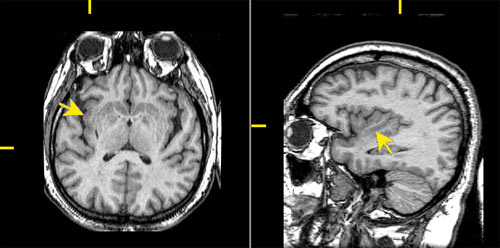 Above: Brain scan with green arrows pointing towards the Insula. |
According to study leader Dr Scanderberg,"The finding of an early and consistent activation of the amygdala-hippocampus complex in the sommelier group suggests a greater motivation for the recognition process.' This may indicate that the sommeliers were expecting a reward and thus pleasure from the wine-tasting process. The other key area is the left dorsolateral prefrontal cortex, which is a zone involved in the planning and use of cognitive (thinking) strategies. The sommeliers' unique activation here is consistent with the idea that only experienced tasters follow specific analytical strategies when wine is in their mouths. The researchers speculate that these strategies might be of a linguistic kind, associating words with specific flavours."
The very activity of applying concepts to smells, tastes and flavours as opposed to merely perceiving them, is an unusual one. As any novice quickly discovers, finding the right words to associate with our perceptions of wine is the difficult pleasure of tasting. Most beginners do not go beyond describing mouth feel sensations - e.g. this wine is 'smooth' or 'harsh', or else they describe one or more of the basic tastes - e.g. this wine is 'sour' or 'sweet'.
Professional wine tasters take a less passive approach.
The above research suggests that the conscious effort of recall required to associate smells and tastes with descriptors means professional tasters are employing developed brain processes different to those of novices. This does not mean that we can't have a shared experience when we taste the same wine - only that shared appreciation generally arises from a similar degree of experience, effort, understanding and possibly even cultural background **.
As Goode comments:"With wine tasting, our sharing of experience through a common culture of wine enables a degree of calibration of perceptual representations to occur. In particular, we develop a language for sensory terms - a way to encode and share our representations...By possessing an extended vocabulary for taste, smell and flavour sensations, we are able to approach wine tasting in a structured fashion and in a way that generates a detailed verbal description of the wine being analysed."
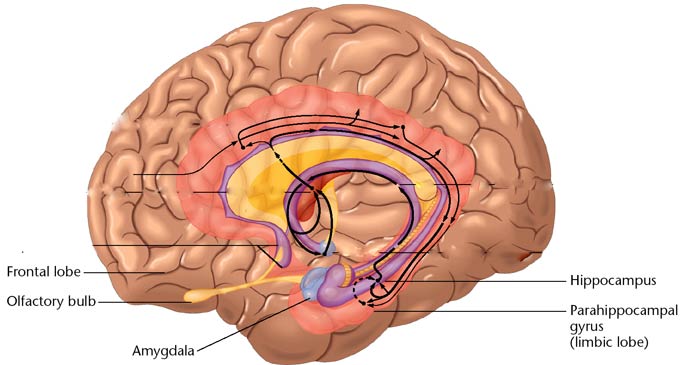
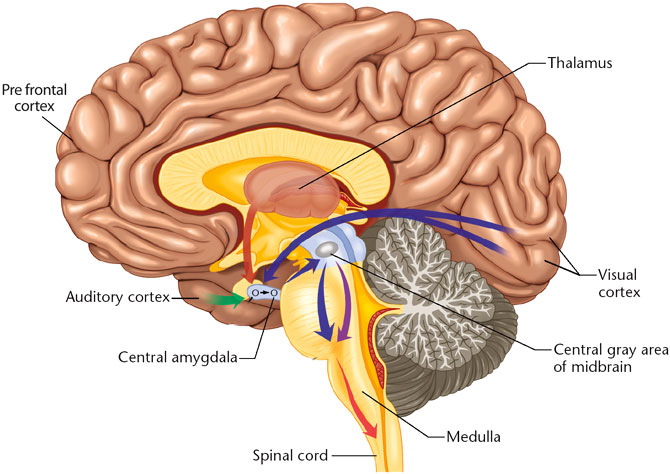
Above: Two Illustrations of the brain identifying the active regions referred to in the experiments, especially the amygdala-hippocampal area.
Another interesting fMRI experiment involved soft drinks:
"Read Montague, a neuro scientist at Baylor College of Medicine in Texas, devised a fascinating experiment that has implications for wine tasting. It stemmed from a series of TV commercials in the 1970s and '80s in which individuals were subjected to the 'Pepsi challenge'. In this test, Pepsi was pitted against Coke blind, with subjects not knowing which was which. They invariably preferred the taste of Pepsi, but this wasn't reflected in their buying decisions. Montague wanted to know why. So he re-enacted the Pepsi challenge with volunteers. e difference was that this time their brain activity was being scanned by an MRI machine. On average, Pepsi produced a stronger response in the ventral putamen, a region thought to process reward. In people who preferred Pepsi, the ventral putamen was five times as active when they drank Pepsi as it was in Coke-preferring subjects drinking Coke. In a clever twist, Montague repeated the experiments, this time telling subjects what they were drinking. Remarkably, most of them now preferred Coke. The brain activity also changed, with activity in the medial prefrontal cortex, a region that shapes high-level cognitive powers. The subjects were allowing what they knew about Coke - its brand image - to shape their preferences. Remarkable. The implications for wine tasting are clear. When we don't taste blind, our preferences are liable to be shaped by pre-existing information we have about the wine. As hard as we try to be objective, this isn't possible. What we know about wine will mould how we perceive the wine, and it will even shape how much we enjoy a particular bottle. This brings another fascinating level of complexity to wine tasting". (2)
The conclusions drawn from these experiments are controversial, leading us naturally onto the subject of persuasion.
Persuasion
It is well known that our 'mental impression' of any given thing can be altered according to another's observations or purpose.
Not in the least is this the case with wine. Let us imagine you've just read a review in a fashionable Gourmet magazine extolling the qualities of a 'special release' wine. The producer is well known - an international name and one which holds high respect. The wine's back label promises"...spicy dark fruits with an elegant structure." You met the wine maker several years ago on a trip to one of your favourite wine regions. You recall him being a straight-shooting & jovial character. Nevertheless, you consult a book to confirm the rating of the vintage and are glad to discover that the wine maker agrees it was one of his better years. That evening after dinner, you are with a friend, a person who is perceived to be somewhat of an authority on the subject of wine, possibly on the basis that he's a big drinker. You offer him the honor, and he uncorks your bottle with a kind of reverence, decanting the wine, then pouring it into two very impressive glasses. You smell and taste the wine but fail to be excited. There is a moment of silence before your esteemed friend declares in astonishment that"the wine is excellent, an outstanding example, wonderfully elegant."He congratulates you on your ability to select wine. You find your friends words so flattering that your consternation dies down and is replaced by the pleasantly embarrassed feeling that flattery arouses. His 'authoritative' description, like the review you read, is probably right, and you are persuaded that the qualities of the wine he has described do exist and you are even beginning to detect them now.
This reconstruction is a typical example of how associative thinking and feeling can effect our perception. By dissecting the situation, we can recognise persuasive powers at play, and begin to understand why judging wines, as opposed to simply tasting wines, requires discipline and concentration. The entire situation is complex and it is exploited by wine marketers and producers alike. The reason for this chapter is to increase one's awareness of the pitfalls that lie ahead.
Tasting notes
As in the experience above, most peoples interest in a wine begins after reading or hearing someone else's opinion of it. The primary means of endorsing a wine is by communicating what a wine smells and tastes like, or better still, offering a tasting. Where tastings are not possible, wine reviews appear in the form of tasting notes sometimes accompanied by a rating or score which suggest an expectation of specific flavours and overall quality. Although tasting notes for wine have been written in English since the early 19th century, the language of wine remains cryptic for many and the lack of 'standard' descriptors confusing. To make matters worse, many wine critics have tended to invent their own vocabulary in order to protect their 'High Priest' status as authorities. The capacity of such people to influence our perception of what we are tasting and smelling should not be underestimated. While certain basic characteristics of wine are readily discernible to most tasters, there is a tendency for people to perceive more subtle odours and tastes once they have been suggested by a 'leader' - even when these odours and tastes do not exist. I can remember a similar incident in a tasting room where a wine was corked and the 'leader' of the group (the supposed expert) did not pick the fault whereas other members of his group thought the wine to be off, but said nothing until another person verified their suspicion. If we are not to be lulled by others, then we need experience, education, and the confidence to rely on our own perceptions. Tasting notes can be of use, but only if the reader is able to interpret them and distinguish the extraneous from the essential. This equally depends upon the motivations of the wine critic, and their ability to taste and to communicate accurately.
Wine reviews, particularly those in newspapers and magazines, should be taken with a dose of scepticism, especially from publications that accept paid advertisements or advertorials from the very same wine company's whose wines are being reviewed. Reviews of mediocre wines will be couched in friendly, non-committal terms. Those with little or no understanding of wine will more likely be persuaded by the 'truth' of seeing something like this in print.
If a wine retailer writes a review, it is in order to sell wine. Those few who bother to write reviews are likely to be committed to sourcing quality wines, those who do not must sell on price and the 'perception' of being value for money. A good retailer will endeavor to be as honest and accurate as possible, the industry is extremely competitive and their business relies on delivering a wine as they've described it. Wine reviews from independent, subscriber based sources can also be reliable guides.
Wine makers also write reviews and sell wine at cellar door tastings. Cellar doors can be both educational and dangerous experiences. Like public tastings, the presence of a jovial, gregarious, larger than life wine maker does nothing to enhance ones objectivity. A professional wine buyers rule is never to make a decision on the spot and maintain a distance from the wine maker or proprietor. Some wine makers believe that they are either manifestations of God, or at least one of the Holy Trinity. A request to purchase a case of their wine can incite a kind of madness. In one scenario, during the first ten minutes of a long distance phone conversation I was submitted to a tirade of self-engrandisement. I agreed with the wine makers opinions to stay on side, and again inquired as to the possibility of purchasing some wine. I was informed there was a 5-7 year waiting list for his mailing list, and how dare I try to buy his wines. This is indeed a strange way to do business. Unfortunately, some people, either charmed or vicariously touched by fame, feel so elated by the experience that they go out and seek the wine paying almost any price. Ones status as a collector is cemented as your friends admire your persistence (having gone through the same tirade themselves), and consider you a privileged person. The construction of an almost insurmountable wall that prohibits ordinary mortals from having access to such wines reinforces the perception that they are only available to a select few. "What you can't have you want." Wine makers who play this game must produce consistently extraordinary wine, and ensure that there remains financial upside for the group of dedicated followers who inevitably do the dirty on 'God' and on-sell the wine at a large profit.
Alone, with no recourse to wine reviews, other Sirens have been prepared to lure us. They begin from the moment we pick up a bottle.
Packaging
In todays mature market, packaging reflects where a wine maker wants to position a product, creating a perception of status, quality and/or value for money. (At the same time, it is important that the packaging does not attempt to disguise mutton as lamb). Fresh, colourful packaging usually reflects inexpensive but good everyday drinking wine. Contemporary graphic designs and moulded bottles of unusual shape, colour and texture aim at reinforcing a perception of being 'fashionable' or unique. Super premium wines, on the other hand, will generally lean towards a more refined, understated or traditional image.
'Icon' labels from long established company's gain the perception of being steadfast, possessing pedigree and distinction. The impact that brands can have upon taste re-presentation is clearly illustrated in a mischievous experiment carried out by Frédéric Brochet, a cognitive psychologist:
"Brochet served the same average-quality wine to people at a week's interval. The twist was that on the first occasion it was packaged and served to people as a vin de table, and on the second as a grand cru wine. So the subjects thought they were tasting a simple wine and then a very special wine, even though it was the same both times. He analysed the terms used in the tasting notes, and it makes telling reading. For the 'grand cru' wine versus the vin de table, 'a lot' replaces 'a little', 'complex' replaces 'simple' and 'balanced' replaces 'unbalanced' - all because of the sight of the label. Brochet explains the results through a phenomenon called perceptive expectation: a subject perceives what they have preperceived, and then they find it difficult to back away from that. For us humans, visual information is much more important than chemosensory information, so we tend to trust vision more. Brochet uses these results to explain Peynaud's observation that 'blind tasting of great wines is often disappointing'."(3)
While many producers strive to maintain consistency of style and quality, vintage variation is inevitable (see below). Here the philosophy of the producer is also significant. Large commercial operations and corporate takeovers often see established brands destroyed, whereby the vineyard falls into the hands of accountants with no understanding of viticulture and with little or no industry experience. Wines which made impressive debuts become 'stretched' in subsequent vintages as production levels supersede quality. Marketing relies on the consumers 'perception' of the brand rather than what's in the bottle. Unfortunately, a negative experience with a brand seems to last in consumers minds a long time. From personal observation, a change of perception is very hard to achieve, and only a very strong plea or a masked taste of the same vineyard's wine will convince a consumer to return to the brand.
To an informed consumer however, packaging and brand should mean less - mediocre presentation from an unknown producer is acceptable as long as the wine is of exceptional quality. One of the worst labels ever produced in Australia was by Albino Zuber for his 1992 Pink Cliffs Heathcote Shiraz. The printing was third rate, the colour was a shocking hot pink, hardly fit for a gentleman's table, yet the wine was of high quality and its price at the time made it an absolute bargain.
Perhaps of more consequence than presentation or brand recognition, are the awards plastered over bottles in the form of gold, silver or bronze stickers. The most cunning example of this kind of marketing is when bottles are labelled "Gold Medal Quality". The wine has not actually won anything, but the producer thought it ought to have.
In Australia, the classic exponent of gold medals was Wolf Blass, who entered wines in an obscure wine show at Lubianna. Each time he entered he won a gold medal which then appeared on the bottle. The suggestion is that if a wine has won awards, it must be good. No one actually bothered to ask where Lubianna was or how the gold medals were awarded. (I believe that the judging process was such that any wine from overseas that could find Lubianna got a Gold Medal. This is not to detract from Wolf who is a master at blending wines). Competitions and competition rules vary around the world, as do systems of appointing judges. In some countries a wine is judged on its own and awarded a medal based upon its own merits. In other shows, wines are judged in groups amongst peer wines, or judged amongst a small selection of local wines. The judging systems vary widely and most are based upon intuitive scoring. Peer pressure is also experienced at wine competitions, where there are three or four judges and one is elected as Chairman or 'leader'. Often the Chairman is regarded as having the greatest knowledge (and prejudices) and will override a debate amongst younger judges whose palates may actually be more acute than his. It is necessary to question the validity of medals and to understand how they have been awarded if we are content to be persuaded by them.
Apart from reviews and visual inputs, price, vintage, the age of a wine, grape variety and district of origin can complicate perceptions further.
Price
While consumers in Australia are becoming better informed about value for money, some still believe that a wines price and quality are brother and sister. They can in fact be far removed cousins. In the 1970's when St Hubert's Wines were owned by the Cester's (of chicken fame), their Cabernet Sauvignon was not selling. At $10 a bottle, the market considered it a little too dear and not worth collecting. Ernie Cester then doubled the price. Suddenly, the market rushed the product perceiving that it must be a fantastic drop to command such a price.
The market in Australia is now a mature one and there is a sufficiently large enough pool of wine expertise to identify an over-priced product. Wine makers and wine marketers continue to use price as a way of positioning their product and creating a perception of a wines quality, rarity and collectibility but the price set will generally have some basis in reality.
The price of many super-premium wines, on the other hand, is simply whatever the market will bare. The price point is artificial and is set as a result of supply and demand. It may climb or fall in the future and does not necessarily relate to quality, scarcity or even production costs. On occasions, a wines price is set quite arbitrarily and has more to do with a wine makers ego or a kind of collective frenzy created by carefully planned publicity.
Many a wine maker will wait for a lead neighbor to set a price and then follow. This is in part the way prices are calculated in Bordeaux, although there are always breakaways that can mesmerize the market with a tiny quantity of very high quality wine at an extraordinary price. Snob value, oneupmanship, and the proliferation of millionaires on a world wide basis ensures that such wines find support. Price is also determined in the Bordeaux markets using an established system of producer, courtier and negociant. The courtier advises the owner / producer of market trends, a small parcel of wine (referred to as a tranche) is put out to the negociants in order to determine the speed of uptake and the market price sensitivity. The remainder of the wine is then released at a price that both satisfies the proprietor and that the negotiant can profit from as well as leaving a future upside for the consumer. There is something left for everyone, leaving the perception that it is not only a great wine but an investment as well.
In the secondary market, to qualify as a potential investment a wine must firstly be from a producer who is serious about producing a top quality product and does so consistently.
Secondly, the wine must be relatively rare. Rarity is almost a foregone conclusion with great wines, since they are usually restricted to specific sites and produced from very low yielding vines. Thirdly, the wine must have an ability to age and improve. This also assists its scarcity, for as time goes on and bottles are consumed, there are fewer of them and those remaining continue to increase in value. The marketers are also aware of these principles, and nothing warms the heart of an investor more than seeing escalating auction prices. Some smaller producers are fudging the system and buying their wine back (under pseudonym) at artificially inflated prices, in order to increase the pricing of the next vintage. The perception is created that the wine is a good investment, and you'll happily pay more for the next release.
Vintage
In some parts of the world, vintages can be reasonably consistent. This is particularly true for areas that are inland or in warmer parts of a country. For example, one would consider Heathcote in Australia consistent. Wines from the region vary from very good commercial quality to some of the finest expressions of Australian Shiraz. However, the closer to the coast one gets or the cooler the climate zone the more vintage variation becomes evident. Cool areas like the Mornington Peninsula in Victoria, are very much dependent upon site specific climates and micro-climates. Wine makers can be notorious for misleading the public, claiming that a current vintage is as good as a previous vintage, particularly when there is a full cellar of wine to sell. Vintages which were average are not discussed until the wine is sold out, but are inevitably downgraded down the track as part of a 're-assessment program'. Wine maker's comments on back labels are often ambiguous. For example, the statement"This wine has won 16 gold medals since 1987 and continues its successful run into the '90's"doesn't say the current vintage is good or bad or of gold medal quality, but it does imply pedigree and hence gives the perception you are purchasing a wine of quality.
District of Origin
The perception of some wine regions as super-premium districts is generated by a small number of outstanding producers who then carry the rest of the district along. In Margaret River, Western Australia for example, brands like Cullen, Moss Wood, Vasse Felix and Leeuwin Estate create an image of excellence and even value for money despite relatively high prices. Their wines are produced in tiny quantities from limited terroirs. Though by no means everyone in the district will share this philosophy. Consequently, wine companies invest millions of dollars in building their brands and consolidating the image of their district. Some districts develop wine associations that are pro-active in marketing their region and protecting its reputation by encouraging producers who might not be up to standard. Other districts such as Swan Hill in Victoria or Griffith in New South Wales are perceived as being large scale bulk wine producing regions. Nevertheless, on an individual basis some exceptional wines can be produced there too. Internationally, Bordeaux, Burgundy, Alsace, Champagne Oporto, the Napa Valley, Rioja etc, have all developed perceptions and expectations of their best wines, their best producers and their best districts. A successful executive will certainly be serving French Champagne at an important dinner party (even if it be an inferior example), rather than a domestically produced Methode Champenoise. The French Champagne houses have convinced the world that 'Champagne' is only from France and have made the drink synonymous with success, celebration, good times and pure indulgence.
Grape Variety
Like Champagne, some grape varieties are associated with 'noble' wines, irrespective of where they are grown. Cabernet Sauvignon, Pinot Noir and Chardonnay are all perceived as being 'great' varieties because when planted in the right place, they consistently produce wines of quality and longevity. Even in lesser environs these varieties can produce more than respectable wines.
Chenin Blanc is capable of producing exceptional wine, although in places like Australia, the variety is perceived as a bulk wine, or a lesser varietal at best. In the Loire Valley, France, Chenin Blanc produces extraordinary wines from Quarts de Chaume, Bonnezeaux and Vouvray. Limited global distribution imposes constraints upon how the variety is perceived in other parts of the world.
Similarly, Gewurztraminer, is highly prized in Alsace, but not in Australia. This is not to say that a grape variety can't be made 'sexy'. In the 1950's, 60's and 70's , Grenache was frowned upon and used for bulk wine blending, cheap pink bubbly or port wine. In the late 1980's Charlie Melton saw the value of old vines Grenache and began to produce Rhone style blends from 100 year old Barossa Vines. The consumer's perception of the varietal changed - Grenache was now a premium. Roman Bratasuik launched his Clarendon Hills Grenache wines at phenomenal prices, and on the other side of the world, Randal Grahm, at Bonny Doon in California, became America's best exponent of the variety. Meanwhile, Mataro, another Rhone variety popularly blended with Grenache, was re-christened Mourvedre, and past perceptions of quality, longevity and value were all turned on their head as a 'new' wine trend emerged.
Today, Italian varietals are being groomed as the next wave of highly sought after varietals in Australia. Pinot Grigio, Sangiovese, Nebbiolo and others are being planted and are favourably compared with their Italian counterparts. The red Italian varietals have a natural disadvantage in that they are generally low pigment wines so display poor colour. Colour is an important indicator of wine flavour and wines with poor quality colour saturation can leave the impression of the wine being prematurely advanced. Time will tell whether these varietals will make the same impact upon Australian and International consumers as Chardonnay and Shiraz.
Age
Poor colour is also a characteristic of old wines which many people perceive to be superior in quality and worth, by virtue of age itself. However, all wines tend to converge (i.e.- become similar) in old age. The primary fruit flavours disappear and the tertiary, developed flavours move in. Regional variations are often lost and what remain are mere skeletons of their former selves. Old reds are not all great - age is not by itself a mender of wine making mistakes nor a means of correcting a poor vintage or bad viticultural practises.
Conclusion
All of the above caveats serve to highlight the need for approaching wine tasting in a structured fashion, with an awareness of the very real variations between individuals and problems derived from these differences. The true complexity of the activity suggests the requirement for an accountable wine tasting methodology based on vocabulary supported by science. The chapters in this section are an attempt to create such a methodology.

Bibliography
1. "Brainwashed by Wine Tasters?" Dr.Jamie Goode, This article originally appeared in Issue 5 of The World of Fine Wine magazine. www.finewinemag.com
* Invented in 1977, magnetic resonance imaging (MRI) is used specifically to view soft tissue. It doesn't use radiation. Instead, a huge magnet moves around the inside of the doughnut. As it does, it creates a magnetic field around the patient's body. Radio waves-without the sound-are then aimed at the patient. The atoms in the body, which are now acting like tiny magnets, create their own waves when they're hit by the MRI radio waves. These waves from the patient's atoms can be measured and turned into pictures by a computer. The result is that doctors can view pictures of the soft tissue of the brain. Functional MRI (FMRI) goes one step beyond MRI by taking pictures of blood flowing through the brain. It adds new information about brain activity because blood flow in the brain increases in those areas where the most activity occurs. So if you're raising your arm or kicking a ball, the blood level in your motor strip will be higher than some of the surrounding areas. It can do a complete scan of the brain in forty milliseconds.
2. "Brainwashed by Wine Tasters?" Dr.Jamie Goode, Ibid.
3. Ibid.
** Dr Charles Spence from the Department of Experimental Psychology at Oxford University comments, 'I have not seen this studied for the case of wine tasting, but for other combinations of taste and smell, your previous experience [for example, in terms of cultural differences in exposure to certain foods or to certain combinations of tastants and odorants] critically determines how your brain will bind the different sensory cues. The brains of Westerners, for example, are especially geared up to binding sweet tastes in the mouth with almond-like odours, but not salty tastes with almond odour. Go to Japan and the reverse is true, because Japanese people never experience the combination of sugar and almond but instead get a lot of exposure to almond and salt taste in pickled vegetables and condiments.'
